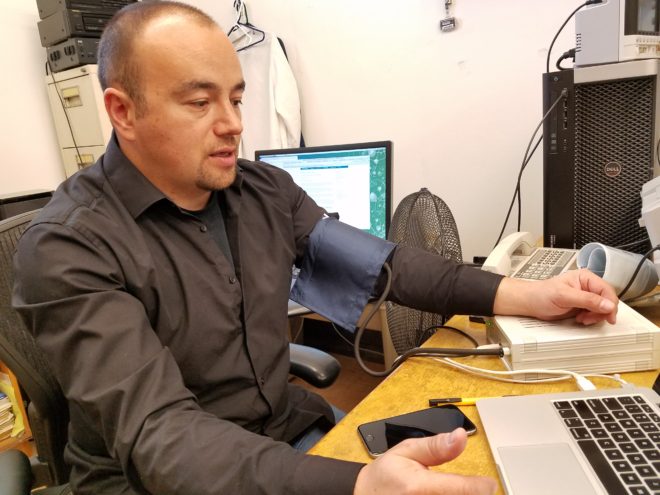What if checking the state of your arterial health were as simple as monitoring your blood pressure? New technology developed at the U.S. Department of Energy’s Lawrence Berkeley National Laboratory (Berkeley Lab) could soon make detecting the process of plaque buildup in vessels a routine part of a visit to the doctor and, perhaps, home healthcare settings.
Jonathan Maltz describes the Engevity Cuff technology that could detect signs of poor arterial health. (Credit: Berkeley Lab)
Early detection of atherosclerosis, the buildup of plaque in and on artery walls, could save lives. Plaque that builds up in blood vessels can eventually burst and cause blood clots, leading to a heart attack or stroke. Cardiovascular disease and stroke are the leading causes of death worldwide, according to the World Health Organization. In the United States, one in every four deaths is attributable to heart disease.
Health professionals have long known that an early sign of atherosclerosis is the decreased ability of arteries to dilate to accommodate changes in blood flow. Measuring the capacity for a vessel to expand helps doctors assess whether the natural active shield against plaque buildup provided by the lining of the arteries is functioning properly. Currently, there is no practical way to do this in a clinic.
Jonathan Maltz, a scientist in Berkeley Lab’s Molecular Biophysics and Integrated Bioimaging division, came up with the idea of using sensors to detect the changes in the pulse pressure as blood flows through the brachial artery, a major vessel in the upper arm. Previous studies have shown a strong correlation between the health of brachial and coronary arteries.
“The beauty of this is that it’s really simple and really low-tech,” said Maltz. “We’re measuring the pulse pressure signal, which is proportional to the volume of fluid in the vessel. As the vessel expands, the cuff is compressed and you get a higher pressure in the cuff. We developed software to then analyze the signals.”
With initial funding from a Berkeley Lab Innovation Grant, Maltz developed an advanced prototype called the Engevity Cuff, which looks and feels much like a blood pressure monitor. He worked with UC San Francisco (UCSF) chief cardiologist Jeffrey Olgin and his team, who are conducting a major heart health study, to test the device on real patients. They found that the cuff was approximately five times more sensitive than ultrasound imaging, an established method of measuring endothelial health that is comparatively expensive and time-consuming. They published their findings in a 2015 study in the journal Physiological Measurement.
Last fall, startup company Lexington Biosciences licensed the technology to help further refine the device and bring it to the medical market.
“This technology could help identify people at greater risk of having a future cardiac event and help them get ahead of the curve to reduce risk,” said Donald McInnes, co-founder of Lexington Biosciences. “It could also be used to provide ongoing monitoring of the efficacy of medication or other prescribed therapies to lower cholesterol. If this were used in a home setting, patients could upload the data to their phones and share the results with their healthcare professional.”
In the meantime, Maltz is collaborating with Jeff Fineman, a UCSF pediatric cardiologist, to adapt the design for use with children. Maltz points out that measuring endothelial health is important in monitoring kids with sickle cell or kidney disease.
# # #
Lawrence Berkeley National Laboratory addresses the world’s most urgent scientific challenges by advancing sustainable energy, protecting human health, creating new materials, and revealing the origin and fate of the universe. Founded in 1931, Berkeley Lab’s scientific expertise has been recognized with 13 Nobel prizes. The University of California manages Berkeley Lab for the U.S. Department of Energy’s Office of Science. For more, visit www.lbl.gov.
DOE’s Office of Science is the single largest supporter of basic research in the physical sciences in the United States, and is working to address some of the most pressing challenges of our time. For more information, please visit science.energy.gov.
